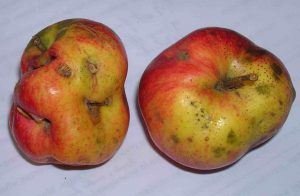Spraying

It is difficult to grow disease-free or pest-free fruit, but an acceptable level can be achieved with good pest management practices such as planting disease resistance varieties, keeping a clean orchard or well-timed sprays.
Pesticides should only be used by those who are aware of the needed precautions. Protective apparel such as gloves and goggles should be worn when mixing and applying any pesticide. When applying chemical sprays, wear eye goggles or a face shield, rubber gloves, long pants, and a long-sleeved shirt. For added protection, also wear rubber boots, a hat and a chemical resistant coat or spray suit. Chemical resistant suits may be purchased at garden stores and some hardware stores. Always wash up or shower after spraying, and wash clothing and other protective equipment separately from other clothing. To prevent chemical drift, spray at times when there is very little wind. Early morning and evening are often the best conditions for spray application.

Always read the label and follow instructions when using a fungicide or insecticide. All chemicals, whether they are organic or synthetic pesticides, should be locked up where children and pets cannot get to them.
For adequate control with chemical sprays, leaves and fruit must be sprayed thoroughly. Most home and garden fruit tree spray products are designed to be applied in a “dilute” spray that wets all leaf and fruit surfaces to the point that if more were sprayed, it would simply run off. The amount of pesticide to mix per gallon of water is stated on the product label. Always follow the label instructions for mixing rates and for safety precautions. The amount of spray needed to thoroughly cover a tree depends on the size and thickness of the tree canopy. The following table provides a rough guideline, but it is better to measure how much water it takes to spray all leaf and fruit surfaces.
| Applying a Dilute Spray Estimated amount of water needed to spray fruit tree foliage at different stages of the season. |
|||
| Tree height and width (feet) | Volume of water | ||
|---|---|---|---|
| Bud break | Mid-season | Late-season | |
| 8 | 1 pint | 1.5 pints | 1 quart |
| 10 | 1 quart | 1.5 quarts | 2 quarts |
| 12 | 2 quarts | 3 quarts | 1 gallon |
| 14 | 3-4 quarts | 1.3 gallons | 1.8 gallons |
| 16 | 1.4 gallons | 1.9 gallons | 2.7 gallons |
The amount of water needed for a dilute spray increases as the growing season progresses from spring into summer. In spring, when the leaf canopy is just starting to grow, a smaller volume is sufficient. In summer, when the tree has a full canopy of leaves, a larger volume will be needed.
